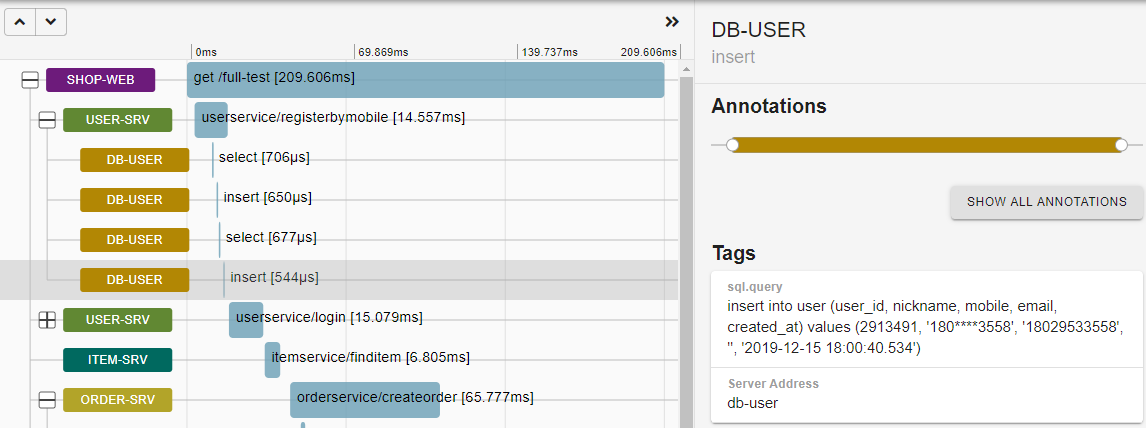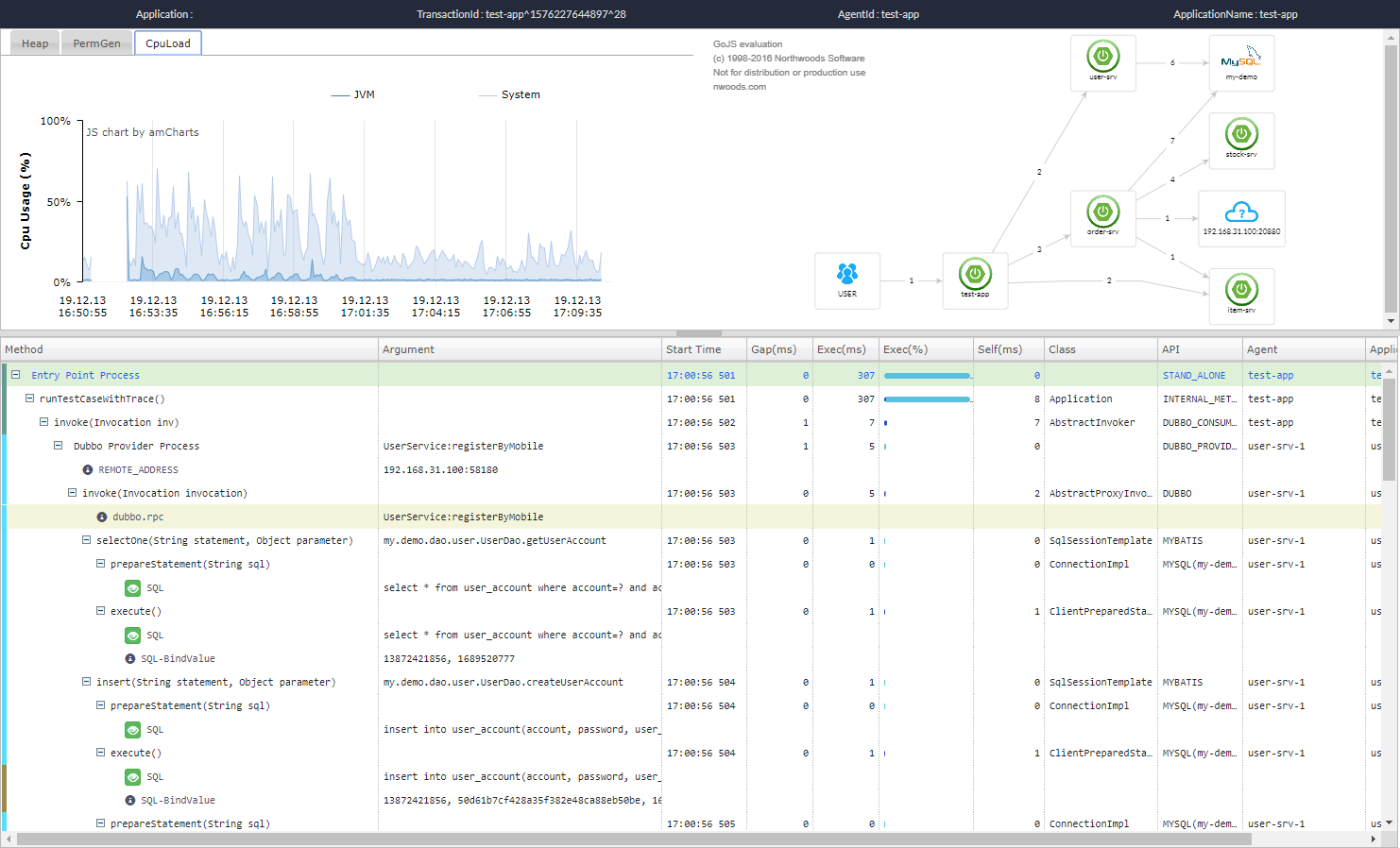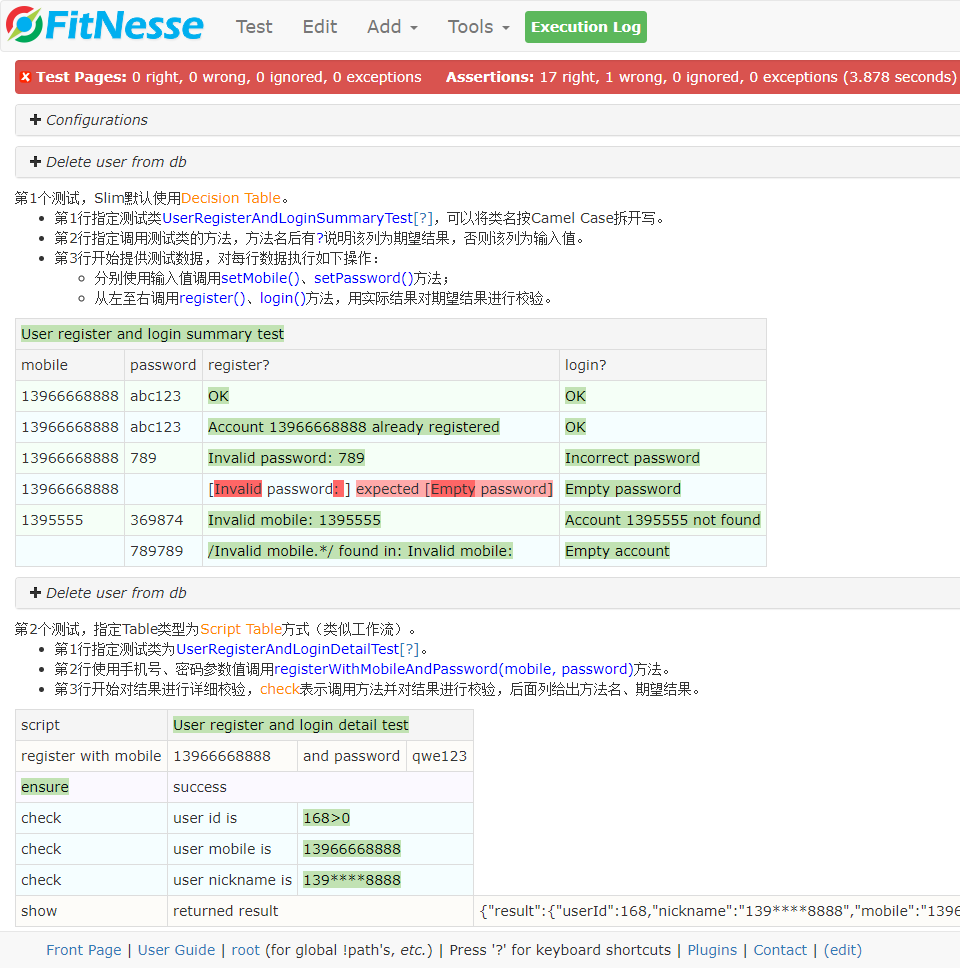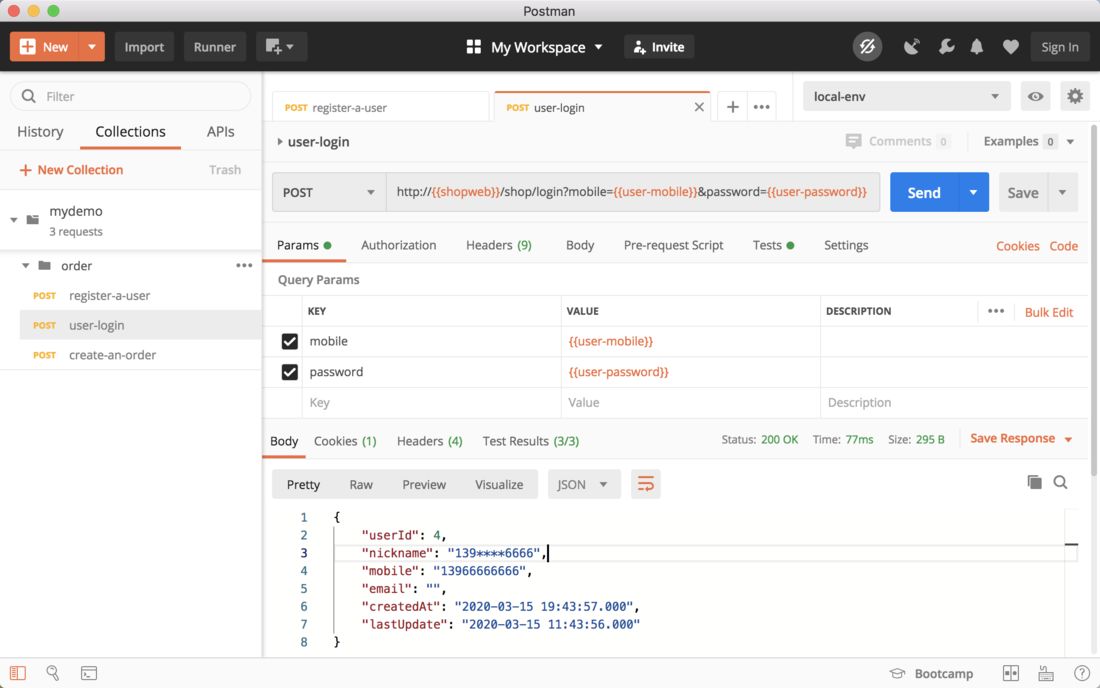A simple demo application for building scalable applications using Microservices, Database Sharding Proxies, Flexible Transactions, APM tools, and deploying to Docker and Kubernetes.
- Dubbo: A high-performance, java based open source RPC framework.
Dubboemploys a client based, decentralized load balance mechanism. Consumers fetch providers from registry servers to client at startup, create long living TCP connections and comunicate directly to providers (fordubbo/thriftprotocols), with variant configurable load balance and fail over algorithms. Availability of providers is detected by heartbeat, and new provider registration events are notified by registry servers to all consumers.
Dubboprovides better performance thanSpring Cloud, it can be deployed and scaled inKubernetes, using its own service discovery, load balance and fail over mechanisms, but it's difficult to work withIstio. - Nacos: A naming and config service, providing more enhancements on service discovery and flow control than Zookeeper.
- ShardingProxy, Mycat: Both are database sharding proxies, providing a transparent database sharding solution.
The internals are very similar, both implementMySQLprotocol to comunicate with cross platform applications, intercept SQL queries and route to backendMySQLservers based on sharding keys and configurable sharding rules. Although it's not recommemded but both of them support cross-sharding queries (without sharding keys in SQL), rewrite SQL if necessary, dispatch queries to all backendMySQLservers, gather results and do aggregation, sorting, pagination in proxy memory, and return result to client. - Seata: A flexible transaction framework for distributed applications.
Seataimplements three transaction modes: AT, TCC and SAGA. The demo application usesATmode, it's transparent for application code. - ZipKin, PinPoint, SkyWalking: APM tools for microservices,
ZipKinandSkyWalkingcan work withIstio.
- OS: Linux, Mac, or Windows with a bash shell, such as git bash;
In Mac OSX
gnu-sedis required:brew install gnu-sed - JDK 8+ and apache maven;
Docker, 6GB memory forDocker Desktopis recommended;
Use package.sh to compile and package the demo application.
Usage:
- Options to enable database sharding:
-mycat,-shardingproxy - Options to enable global transaction management:
-seata - Options to enable APM:
-skywalking,-pinpoint,-zipkin
Example:
package.sh -mycat -zipkin
package.sh -shardingproxy -pinpoint -seataMySQLandNacosmust be installed, see MySQL scripts and Nacos quickstart.- Install and start 3-party components as you wanted, go to project home for help, and Dockerfiles and scripts in demo application are also references for you.
- Edit parent pom.xml and config for your local environment.
- Use
package.shto compile and package demo application. - Start demo application as following steps: \
- Neither
SkyWalkingnorPinPointis enabled:java -jar item-service\target\item-service-0.0.1-SNAPSHOT.jar java -jar stock-service\target\stock-service-0.0.1-SNAPSHOT.jar java -jar user-service\target\user-service-0.0.1-SNAPSHOT.jar java -jar order-service\target\order-service-0.0.1-SNAPSHOT.jar java -jar shop-web\target\shop-web-0.0.1-SNAPSHOT.jar
SkyWalkingis enabled:java -javaagent:F:\sw\agent\skywalking-agent.jar -Dskywalking.agent.service_name=svc-item -jar item-service\target\item-service-0.0.1-SNAPSHOT.jar java -javaagent:F:\sw\agent\skywalking-agent.jar -Dskywalking.agent.service_name=svc-stock -jar stock-service\target\stock-service-0.0.1-SNAPSHOT.jar java -javaagent:F:\sw\agent\skywalking-agent.jar -Dskywalking.agent.service_name=svc-user -jar user-service\target\user-service-0.0.1-SNAPSHOT.jar java -javaagent:F:\sw\agent\skywalking-agent.jar -Dskywalking.agent.service_name=svc-order -jar order-service\target\order-service-0.0.1-SNAPSHOT.jar java -javaagent:F:\sw\agent\skywalking-agent.jar -Dskywalking.agent.service_name=shop-web -jar shop-web\target\shop-web-0.0.1-SNAPSHOT.jar
PinPointis enabled:java -javaagent:F:\pinpoint\agent\pinpoint-bootstrap-1.8.5.jar -Dpinpoint.agentId=svc-item-1 -Dpinpoint.applicationName=svc-item -jar item-service\target\item-service-0.0.1-SNAPSHOT.jar java -javaagent:F:\pinpoint\agent\pinpoint-bootstrap-1.8.5.jar -Dpinpoint.agentId=svc-stock-1 -Dpinpoint.applicationName=svc-stock -jar stock-service\target\stock-service-0.0.1-SNAPSHOT.jar java -javaagent:F:\pinpoint\agent\pinpoint-bootstrap-1.8.5.jar -Dpinpoint.agentId=svc-user-1 -Dpinpoint.applicationName=svc-user -jar user-service\target\user-service-0.0.1-SNAPSHOT.jar java -javaagent:F:\pinpoint\agent\pinpoint-bootstrap-1.8.5.jar -Dpinpoint.agentId=svc-order-1 -Dpinpoint.applicationName=svc-order -jar order-service\target\order-service-0.0.1-SNAPSHOT.jar java -javaagent:F:\pinpoint\agent\pinpoint-bootstrap-1.8.5.jar -Dpinpoint.agentId=shop-web-1 -Dpinpoint.applicationName=shop-web -jar shop-web\target\shop-web-0.0.1-SNAPSHOT.jar
- Neither
Entrypoints:
- Demo Application: localhost:8090/shop
Nacos: localhost:8848/nacos, user/password:nacos/nacosZipKin: localhost:9411/zipkinSkyWalking: localhost:8080PinPoint:localhost:{your-port}Mycat: data port8066, management port is9066, usemysqlto connect, user/password:mydemo/mydemoIn Mac OSX,
--protocolmust be specified:mysql -h localhost -P 8066 -umydemo -pmydemo --protocol=TCP
ShardingProxy:3307, usemysqlto connect, user/password:mydemo/mydemo
- Build Docker images for all 3-party components used in demo application.
ATTENTION: Docker support for
PinPointis not provided in demo application,-pinpointoption cann't be used inpackage.shif you run the demo application in Docker.docker/build-basis.sh
- Run Docker containers for all 3-party components. It's recommended for you that take
docker/deploy-basis.shas a reference, and only run those containers you wanted, to avoid Docker hungs because of memory pressure.All containers run in adocker/deploy-basis.sh
Docker Networkmydemocreated indocker/deploy-basis.sh,docker-composeis not used. - Use docker/deploy-mydemo.sh to build images and run containers for demo application.
Usage:-build: Build images foritem,stock,user,orderservices andshop-webapp.-run: Run containers foritem,stock,user,orderservices andshop-webapp.-stop: Stop containers foritem,stock,user,orderservices andshop-webapp.-rm: Remove containers foritem,stock,user,orderservices andshop-webapp.-rmi: Remove images foritem,stock,user,orderservices andshop-webapp.
Example:
docker/build-basis.sh
docker/deploy-basis.sh
# Run demo application with Mycat, Seata and ZipKin
package.sh -mycat -seata -zipkin
docker/deploy-mydemo.sh -build -run
# Run demo application with ShardingProxy and SkyWalking
package.sh -shardingproxy -skywaling
docker/deploy-mydemo.sh -stop -rm -rmi -build -runEntrypoints:
- Demo Application: localhost:18090/shop
Nacos: localhost:18848/nacos, user/password:nacos/nacosZipKin: localhost:19411/zipkinSkyWalking: localhost:18080Mycat: data port18066, management port19066, usemysqlto connect, user/password:mydemo/mydemoIn Mac OSX,
--protocolmust be specified:mysql -h localhost -P 18066 -umydemo -pmydemo --protocol=TCP
ShardingProxy:13307, usemysqlto connect, user/password:mydemo/mydemoMySQL:13306, usemysqlto connect, user/password:root/123
The YAML and script files in k8s/ run the demo application with Mycat and ZipKin in Kubernetes.
- Build Docker images for all 3-party components used in the demo application.
docker/build-basis.sh
- Deploy demo application in
Kubernetes:k8s/deploy-k8s.sh
Entrypoints:
- Demo Application: localhost:30090/shop
Nacos: localhost:30048/nacos, user/password:nacos/nacosZipKin: localhost:30041/zipkinMycat: data port is30066, management port is30067, usemysqlto connect, user/password:mydemo/mydemoIn Mac OSX,
--protocolmust be specified:mysql -h localhost -P 30066 -umydemo -pmydemo --protocol=TCP
MySQL:30006, usemysqlto connect, user/password:root/123
Dubbo in Kubernetes
Dubbo services are deployed by Kubernetes Deployment, and not registered as Kubernetes Service. They use Dubbo's own service descovery, load balance, providers take POD IP to register to Nacos, consumers fetch providers from Nacos and comunicate with all providers by POD IP. Dubbo services can be managed by Deployment, the following example scripts show how to scale svc-user to 3 PODs. New POD ready and existing POD terminated events can be discovered by Dubbo.
# Scale user-service to 3 PODs
kubectl scale Deployment svc-user --replicas=3
# Open 3 terminals to watch user-service logs
# 1. Find user-service PODs
kubectl get pods | grep svc-user
# 2. Watch logs for each svc-user POD
kubectl logs svc-user-68ff844499-9zqf8 -c svc-user -f
kubectl logs svc-user-68ff844499-dgsnx -c svc-user -f
...
# 3. Open http://localhost:30090/shop, Click "Run a Full TestCase" button and watch which user-service instance is used.The YAML and script files in istio/ is a simple example for running shop-web with Istio, YAML files are the same with those in k8s/ except web-shop-deployment.yaml. It's tested in Docker Desktop, with Istio installed and default namespace enabled for istio-injection as following:
istioctl manifest apply --set profile=demo
kubectl label ns default istio-injection=enabled --overwriteRun demo application:
docker/build-basis.sh
istio/deploy-istio.shBind myshop.com to local machine IP in hosts file, and use http://myshop.com/hello/YourName to visit.
shop-web is deployed with two versions: 2 PODs for v1 and 1 POD for v2, default route to v1, use URL query param version=v2 to route to v2. This is achieved by VirtualService and DestinationRule in istio/deployment/web-shop-deployment.yaml.
Dubbo services using dubbo/thrift/rmi protocols cann't work with Istio, if use http/rest/webservice protocols, Spring Boot is a better choice rather than Dubbo.












